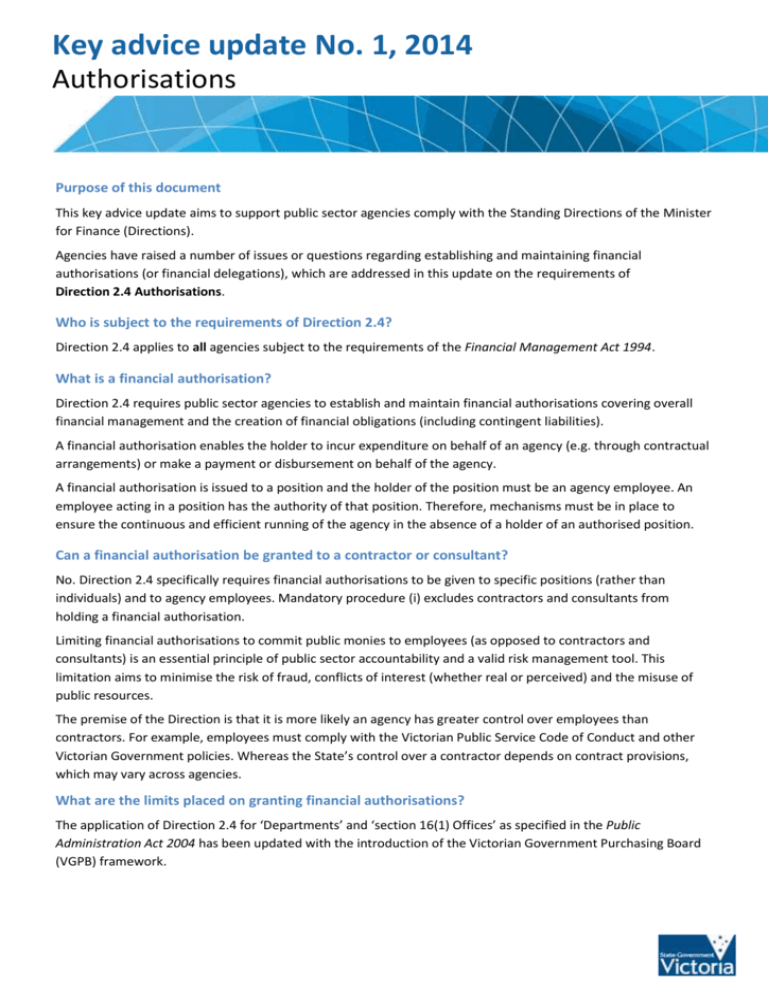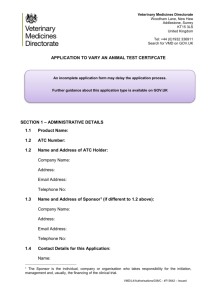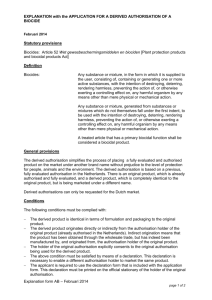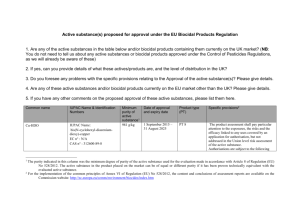Key Advice Update No 1. 2014 - Authorisations
advertisement

Key advice update No. 1, 2014 Authorisations Purpose of this document This key advice update aims to support public sector agencies comply with the Standing Directions of the Minister for Finance (Directions). Agencies have raised a number of issues or questions regarding establishing and maintaining financial authorisations (or financial delegations), which are addressed in this update on the requirements of Direction 2.4 Authorisations. Who is subject to the requirements of Direction 2.4? Direction 2.4 applies to all agencies subject to the requirements of the Financial Management Act 1994. What is a financial authorisation? Direction 2.4 requires public sector agencies to establish and maintain financial authorisations covering overall financial management and the creation of financial obligations (including contingent liabilities). A financial authorisation enables the holder to incur expenditure on behalf of an agency (e.g. through contractual arrangements) or make a payment or disbursement on behalf of the agency. A financial authorisation is issued to a position and the holder of the position must be an agency employee. An employee acting in a position has the authority of that position. Therefore, mechanisms must be in place to ensure the continuous and efficient running of the agency in the absence of a holder of an authorised position. Can a financial authorisation be granted to a contractor or consultant? No. Direction 2.4 specifically requires financial authorisations to be given to specific positions (rather than individuals) and to agency employees. Mandatory procedure (i) excludes contractors and consultants from holding a financial authorisation. Limiting financial authorisations to commit public monies to employees (as opposed to contractors and consultants) is an essential principle of public sector accountability and a valid risk management tool. This limitation aims to minimise the risk of fraud, conflicts of interest (whether real or perceived) and the misuse of public resources. The premise of the Direction is that it is more likely an agency has greater control over employees than contractors. For example, employees must comply with the Victorian Public Service Code of Conduct and other Victorian Government policies. Whereas the State’s control over a contractor depends on contract provisions, which may vary across agencies. What are the limits placed on granting financial authorisations? The application of Direction 2.4 for ‘Departments’ and ‘section 16(1) Offices’ as specified in the Public Administration Act 2004 has been updated with the introduction of the Victorian Government Purchasing Board (VGPB) framework. The following table summarises who may confer financial authorisations and the different limits placed on them for public sector agencies: Entity type Limits imposed on financial authorisations by Direction 2.4 Departments that have transitioned to Victorian Government Purchasing Board’s (VGPB’s) policy framework Who can confer a financial authorisation? and S16 (1) Offices under the Public Administration Act 2004 The Responsible Body is able to confer any limit for a financial authorisation on any officer (i.e. employee) directly. For Departments, the Responsible Body is the Minister, or Ministers jointly if there is more than one. For section 16(1) Offices, the Responsible Body is the Minister for the time being administering the enabling legislation. How many financial authorisations can be conferred and to what financial limit? There is no limit to the number of financial authorisations that can be conferred. A financial limit must be set for each financial authorisation. The words ‘any limit’ are not to be interpreted as allowing an ‘unlimited’ conferral. Example: A Responsible Body (i.e. the Minister) may confer the following delegations Employee A (Accountable Officer) - $100 million, Employee B - $10 million and Employee C $50 million. The conferred limit is the maximum an officer/employee can approve for each financial transaction. See Diagram 1. Can the Responsible Body sub-delegate the power to give financial authorisations? Yes. For Departments, the Responsible Body may delegate to the Accountable Officer (Secretary) the power to give financial authorisation to a position up to but not exceeding $10 million. For a section 16(1) Office, the Responsible Body may delegate to the person with the functions of a public service body head the power to give financial authorisation to a position up to but not exceeding $10 million. Example: An Accountable Officer with a $10 million delegation may confer the following delegations - (Position A - $10 million, Position B - $10 million and Position C - $5 million). See Diagram 1. Can the Responsible Body delegate any other responsibilities under Direction 2.4? Yes. The Responsible Body may delegate to the Accountable Officer some or all of their responsibilities under Direction 2.4 except the power to give financial authorisations exceeding $10 million. 2 Entity type Limits imposed on financial authorisations by Direction 2.4 Departments that have not transitioned to the VGPB’s framework (applicable up to December 2014) The former Direction 2.4 requirements remain in force until a Department has transitioned to VGPB’s framework. Who can confer a financial authorisation? The Responsible Body is able to confer any limit on a departmental officer (e.g. authorise an employee to spend up to a designated amount). How many financial authorisations can be conferred and to what financial limit? There is no limit to the number of financial authorisations that can be conferred. A financial limit must be set for each financial authorisation. The words ‘any limit’ are not to be interpreted as allowing an ‘unlimited’ conferral. The conferred limit is the maximum an officer/employee can approve for each financial transaction. Can the Responsible Body sub-delegate the power to give financial authorisations? Yes. The Responsible Body may delegate to the Secretary (i.e. Accountable Officer) the power to give financial authorisations to a position, but not exceeding the accreditation limit applicable (as determined by the VGPB’s purchasing accreditation of that Department). Can the Responsible Body delegate any other responsibilities under Direction 2.4? Yes. The Responsible Body may delegate to the Secretary (i.e. Accountable Officer) some or all of the powers and responsibilities given to the Responsible Body by Direction 2.4, except the power to give financial authorisations exceeding the accreditation limit applicable. Entity type Limits imposed on financial authorisations by Direction 2.4 Public Sector Agencies (other than Departments or Section 16(1) Offices) Who can confer a financial authorisation? The Responsible Body is able to confer any limit on a position (e.g. authorise an employee to spend up to a designated amount). The Responsible Body is the board, or in the absence of a board, the person or body that is charged with the oversight of the public sector agency’s operations. How many financial authorisations can be conferred and to what financial limit? There is no limit to the number of financial authorisations that can be conferred. There is no specified financial maximum limit set for each financial authorisation. When setting an appropriate maximum limit for the agency, the Responsible Body should take into account the agency’s size, function and risk profile. A financial limit must be set for each financial authorisation. This limit is the maximum an employee can approve for each financial transaction. Example: The Responsible Body may confer the following delegations - Employee A - $50 million, Employee B - $20 million, Employee C - $5 million and Employee D - $1 million. Diagram 1 Financial authorisation for Departments and s16(1) Offices Responsible Body (Minister) Directly confer an authorisation with a limit Employee C $10m Employee B $50m Delegate power to give financial authorisations up to $10m Employee A (eg. Accountable Officer/Public service body Head) $100m Accountable Officer of Department or ‘public service body Head’ of s16(1) Office Each financial authorisation to a max limit of $10m Position A $10m Position B $10m Position C $5m 4 What are the other Direction 2.4 requirements relating to financial authorisations? The following requirements specified by Direction 2.4 for the creation, exercise and management of financial authorisations are applicable to all public sector agencies (i.e. including Departments and section 16(1) Offices). In summary, the Directions provide that: the Responsible Body must give clear financial authorisations to specific positions; a financial authorisation is to cease immediately following a change in the name of a specified position or a substantial or material change in its duties; a register of financial authorisations must be established and maintained, and legal requirements for document retention and record keeping must be observed (including audit trails); internal controls must not be compromised in the case of a specified position having more than one financial authorisation assigned to it; the Responsible Body must annually review the register of financial authorisations (categories and types) and make any necessary changes; and a financial authorisation cannot be sub delegated (except as specified above by the Responsible Body in Departments and section 16(1) Offices). What should a register of financial authorisations contain? Direction 2.4 requires an agency to establish and maintain a register of financial authorisations. The content of the register should support the requirements of Direction 2.4 and this is likely to include: a list of positions holding financial authority for each transaction type (e.g. financing, investing and operational); dollar caps for each transaction or financial authorisation type; a list of staff names holding the positions with financial authority (this list should be regularly updated and communicated to all relevant staff including the holders of the financial authorisation and the Chief Finance and Accounting Officer); and specimen signatures for each holder of an authorised position (public sector agencies that have advanced to electronic procurement should ensure financial authorisation processes are met in an adequate electronic form that can be audited). What happens to financial authorisations when there is a significant organisation restructure? In the event of a significant restructure of a public sector agency (for this purpose ‘total restructure’ means a restructure affecting 50 per cent or more of the positions in the public sector agency), both the Responsible Body and Accountable Officer should be informed of implications for financial authorisations and the financial authorisations reassessed and reapproved within one calendar month. As a matter of good practice, public sector agencies should also adopt processes to ensure that financial authorisations are reassessed and reconfirmed within one calendar month of changes in the Responsible Body or Accountable Officer. What is the process for remaking financial authorisations within Departments following machineryof-government changes? Following the announcement of machinery-of-government changes, Departments should endeavour to facilitate the making of new authorisations to ensure they are in place from the effective date of the proposed changes. For Departments, the Responsible Body (who confers the financial authorisations) is the Minister or the Ministers jointly if there is more than one Minister for that Department. Accordingly, in a Department with multiple portfolio Ministers, a financial authorisation must be conferred ‘jointly’ by all of its respective Ministers. A financial authorisation may be conferred ‘jointly’ by having each Minister sign the one instrument of authorisation (i.e. the same document). Alternatively, each Minister could provide separate written authorisations by signing a counterpart copy of the instrument of authorisation. Equally, when remaking financial authorisations, each relevant Minister could sign the one instrument of authorisation or provide separate written authorisations by signing a counterpart copy of the instrument of authorisation. If an instrument of authorisation is being signed in counterpart, it should expressly state that it is to be (or can be) signed in counterpart by the relevant Ministers. Departments should also advise their Ministers that each portfolio Minister has been provided with a counterpart copy for signature. You are free to re-use this work under a Creative Commons Attribution 3.0 Australia licence, on the condition that you credit the State of Victoria as author. The licence does not apply to any images, photographs or branding. 6








